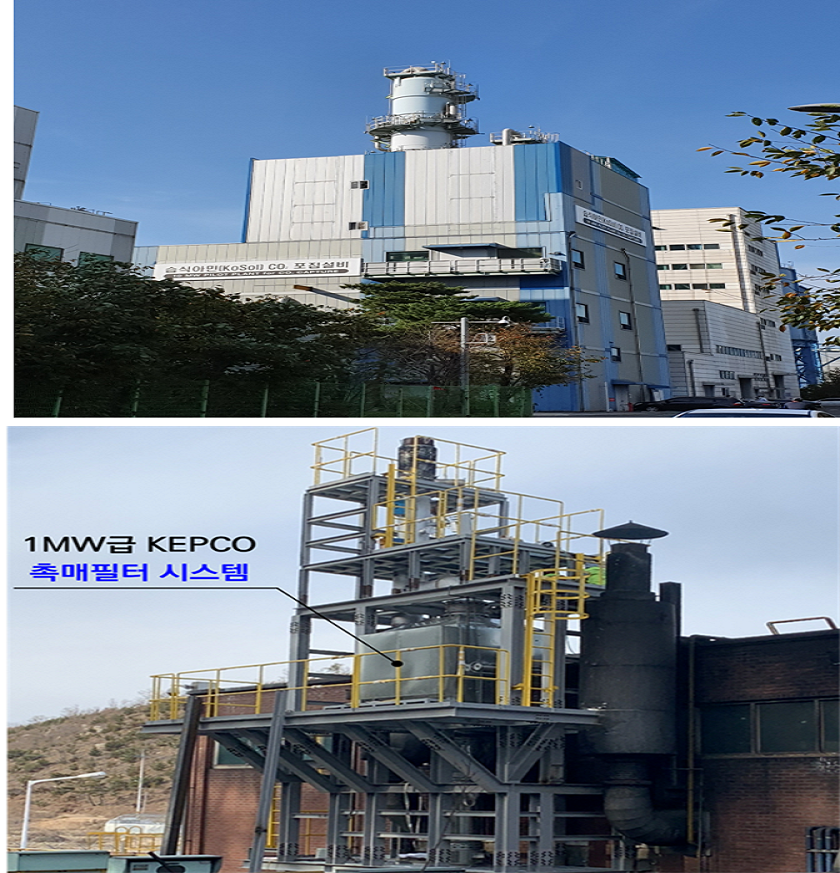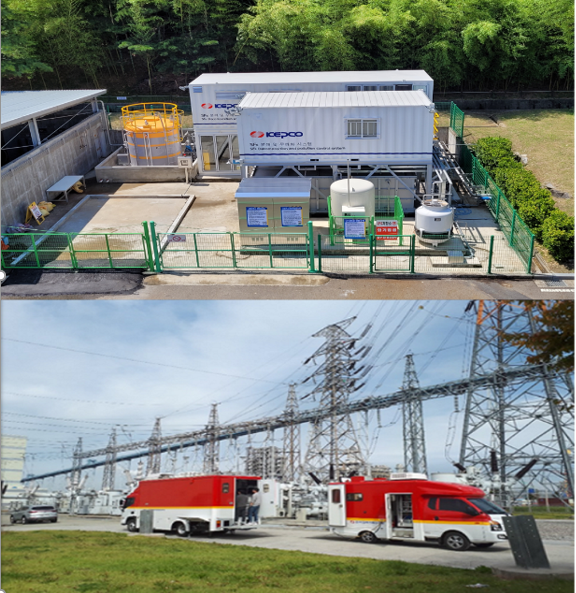Climate Change & Environment
Fields of our research Climate Change & EnvironmentThe energy & environment laboratory is concentrating its competencies on developing technology and the commercialization thereof for greenhouse gas mitigation, improving new energy and hydrogen energy efficiency, reducing environmental pollution. CO2 capture and utilization technology has been developed and exhibited world-class performances. SF6 analysis, refinement, and decomposition technologies have been developed to reduce SF6 from power facilities. As the next power generation technology, the 2MW super critical CO2 power generation system using waste heat from engines is being developed for the first time in the world. To cope with the policy of expanding renewable energy, the technologies for green hydrogen production and hydrogen storage using renewable energy power has been developed. To preemptively implement the fine particle reduction policy, the evaluation of particulate diffusion effects, investigation of secondary generation mechanisms, and power plant particulate measurement/evaluation technology have been developed. Furthermore, we are accelerating the development of technologies for the prevention and diagnosis of power facilities, such as the technology for transformer deterioration diagnosis, the oil-filled cable diagnosis technology for underground transmission, and the development of multi-gas sensor for real-time condition monotoring of transformers.
Carbon Dioxide Capture Technology
CO2 capture technology has been developed to reduce CO2 emissions from large-scale emission sources such as thermal power plants. The technology development is in progress in accordance with the national carbon capture and storage (CCS) road-map. An integrated CO2 capture demonstration project involving CO2 storage and scale-up studies have been carried out using the 10MW advanced amine CO2 capture pilot plant installed at the Boryeong thermal power plant. This project contributed to a reduction in costs regarding the purchase of greenhouse gas emission rights (KRW 1.5 billion/year, based on 50,000 tons). Another 10MW CO2 capture pilot plant that uses a solid sorbent has been in operation since 2013 at the Hadong thermal power plant with which process optimization, CO2 liquefaction and scale-up studies are underway to improve dry capture technology. The Oxygen Carriers have been developed for Chemical Looping Combustion technology, and we plans to develop distributed power generation plants through demonstration of 3 MWth steam generation.
Carbon Dioxide Utilization Technology
Carbon dioxide utilization technology is a technology that converts CO2 into various materials and creates added value while reducing greenhouse gases. The pilot demonstration of 200kg CO2/day was completed by developing a technology for converting flue gas discharged from power plants into useful compounds such as sodium bicarbonate without a separation process. In addition, biological methanation process has been developed that produces methane gas from carbon dioxide and hydrogen derived from renewable energy using microorganisms developed in-house. In particular, the biological methanation process is a representative P2G technology and will be demonstrated in connection with KEPCO-MG through government support.
SF6 Analysis/Purification/Decomposition Technology
KEPCO has developed the technology for the SF6 lifecycle (recovery - purification - decomposition) step by step to reduce the use of SF6, the representative greenhouse gas. The SF6 purification technology was developed to reuse SF6 as insulation gas by building precision gas analysis infrastructure and cryogenic purification method for establishing over 99% of SF6 purity. The developed technology has been demonstrated at the Okcheon Climate Change Response Center and is being utilized. In addition, the SF6 decomposition technology has been developing to eliminate SF6 harmlessly according to the plan to supply eco-friendly GIS in power facilities. The SF6 decomposition characteristic was evaluated by lap-scale test, and the design basis of a commercial scale facility was found. Consequently, the SF6 decomposition and pollution control system designed to handle an annual 60-ton of SF6 was constructed in the KEPCO research institute, and its performance has been evaluating. Hereafter, the SF6 decomposition technology will be utilized to eliminate useless SF6 in KEPCO.
Energy Efficiency Improvement Technology
We are focusing on the hybrid energy system development to reduce greenhouse gases and to improve power generation efficiency and the economics of renewable energy. Supercritical CO2 power generation technology, which can be connected to waste heat has been completed in the design of a 2MW generation system and the manufacturing of unit devices. ORC generation technology that recovers waste heat has been employed to develop a 30 kW generation system that utilizes the waste heat of the island diesel engine. Demonstration was completed in Heuksan Island. A 1.5MW class dual fuel power generation system has been built in Baengnyeong island for the first time in Korea 2019. We plan to demonstrate system and examine reduction effect of air pollutants, so that expand to other islands. Also, for higher energy efficiency, an empirical study is in progress to not only do field-test of residential integrated heat pump for heating and cooling but also establish the residential heat pump standards.
Bioenergy Conversion Technology
We are investigating the energy conversion technology to improve greenhouse gas generation and environmental problems caused by livestock manure, which generates more than 50 million tons a year, and to convert electricity for heating in the agricultural and livestock sector into bioenergy. 2MWth scale livestock solid manure fuel boiler integrated thermal-electricity generation facility has been developed, and the demonstration is in progress.
Blue・Turquoise hydrogen production technology
With the expansion of hydrogen power generation, blue and turquoise hydrogen technologies have been developing to supply clean hydrogen. We developed core technologies, which are redox materials and chemical process design, for the blue hydrogen technology which produces high-purity hydrogen and capture carbon dioxide simultaneously. We developed a 20kWth blue hydrogen production pilot system and design of MW-scale system is being conducted with demonstration data of pilot system. Development of turquoise hydrogen technology, which produces hydrogen and value-added carbon by methane decompostion with metal catalys, has been started. We are devoloping a 20kWth turquoise-hydrogen production pilot system and MW-scale system design technology.
PM/NOx Simultaneous Removal Technology
KEPCO have developed PM·NOx simultaneous removal technology over Catalytic Filter system as a preemptive response to deal with the strengthened environmental regulations in islands. KEPCO proprietary catalytic filter has been developed and evaluated the performance on the 500 kW class engine. As a result of field test, the PM·NOx simultaneous removal efficiency was more than 90%. On the basis of the performance evaluation and process optimization connected to the 80 kW class engine, We have designed MW class of Catalytic Filter system and built a demonstration facility of 1 MW class in Yeonpyeong-island. Also, We plan to conduct a business projects on ship industry through technology spin-off as well as the stationary diesel engine applications.
Diagnosis of Electric Power Facilities by Sensing Technology
Diagnosis technology based on gas sensors has been developed for effective and stable operation of electric power facilities. In order to achieve real time surveillance of a transformer, gas sensors capable of detecting very small amount of gas up to a few ppm level have been developed. The sensors have been developed in a form of probe which simplifies the structure, improves reliability, and could be inserted into transformer oil directly. Recently, high reliability sensors capable of detecting the hydrogen/oxygen concentration inside high pressure gas pipelines of hydrogen facilities have been developed to monitor the status of the facilities and take preemptive responses to possible crises. They are going to be developed to explosion proof module for application of water electrolysis. In the future, the application filed of sensing diagnosis will be expanded to various energy/power facilities such as power transmission cables or hydrogen infrastucture.
Measurement and Evaluation Technologies for Fine Particles
In order to secure a foundation for the operation of clean power and preemptively implement reduction policies for fine particles and measures to reduce fine particles, an evaluation of the emission of fine particles and particulate precursors discharged from power plants was carried out for the first time in Korea. We established a mobile measurement system for the evaluation of the generation and behavior of secondary fine particles in the environment around power plants. Also we developed an automatic continuous measurement system of fine particles and installed a real-time monitoring base for the fine particles emissions from power plants. After standardization of automatic continuous measurement technology of fine particles in flue gas, the measurement system will be expanded its application to power plants.
Fine Particles Reduction Technologies
In order to reduce fine particles in the air, new technologies are developed for reducing precursor of fine particles such as SOx, NOx, VOCs from power plants. The technologies include CO/VOCs removal in coal shed, electrostatic precipitator particle coarsening, multi-functional SCR(Selective Catalytic Reduction) catalyst for gas turbine, and ammonia slip removal in deNOx facility for reducing the precursor of fine particles from power plants.
Diagnosis of Deteriorated Conditions at Electric Power Facilities
The world's first portable furan diagnostic kit, developed to quickly diagnose the deteriorated condition of transformers, has been applied to ground distribution transformers in KEPCO since 2022, and is expanding domestic and foreign technology businesses. In addition, in preparation for the 4th Industrial Revolution, a Color-responsive polymer test kit for diagnosing life of transformers that do not use reaction reagents was developed and field tests were completed at the Namseoul branch. And for predicting the residual life of power OF and XLPE cables, KEPCO has developed measurement technology and derived key factors for insulation degradation for AMS(Asset Management System). KEPRI is developing management standards to prevent failure of transformer bushing, and is leading the prevention and diagnosis technology of power facilities by developing core technologies for diagnosis of power facilities in Korea, such as eco-friendly transformer operation technology at offshore substations.


